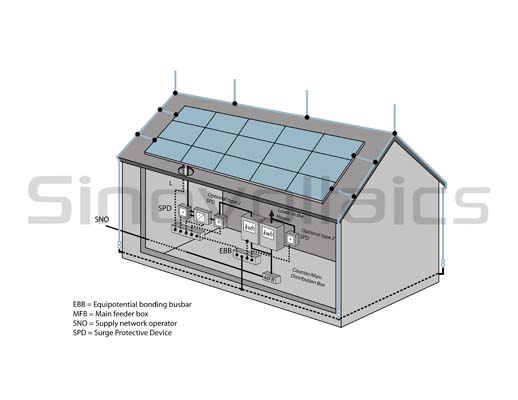Meteodyn PV
DDS-CAD PV
PV F-CHART
Electrical Grid Shuts Down
Smart MicroGrids
Choosing the Right Batteries for Your Solar System
Fuses in PV Systems
Circuit Breakers in PV Systems
[...]
 What is a Surge Protector?
A surge protector, (rather, a surge limiter) is any device which clip the surge beyond a specified value. The easiest comparison is a Zener circuit or limiting voltage rises. The surge protector (limiter) is connected in parallel with the equipment to be protected. As long as the voltage is less than the “knee voltage”, the device offers a high impedance to the line, drawing little or no current. When the voltage tries to rise above the specified value, the device impedance starts decreasing to a very low value, thus shunting the current down to earth. Surge energy is dissipated through the limiter, and voltage on the line is limited (clamped) to a safe specified value. The clamping voltage of a surge limiter must be less than the voltage the protected equipment can inherently withstand. For example, if a set-up is designed to withstand 1500 VDC, the protecting limiter must operate below that voltage.Construction
Surge protectors normally use bulk semiconductor Metal Oxide Varistors (MOV). Zinc oxide granules are typically used. Layers of MOVs in series can be combined to achieve a desired limiting or clamping voltage. The current capability will depend on the cross-section area, and devices can be connected in parallel. Spark gaps are also used as surge limiters. A sealed bulb is filled with an ionizable gas. External contacts are terminated into the bulb. When the voltage across the device tries to exceed the design limit the electric field across the contacts crosses the ionization field of the gas. The gas ionizes, allowing a low resistance current path. The voltage gets limited.Protecting PV SystemsAs surge protectors are expected shunt extra energy to the earth, a good connection to the system earth Is necessary. Surge limiters must be placed at all points which are subject to lightning discharge, and to transients from other systems. Find out more here: https://solarprofessional.com/articles/design-installation/surge-protection-devices-for-pv-installations#.XCWqO1wzbIU
• Surge limiters at the output of the grid-connected inverter will protect the PV system from surges and spikes from the grid lines.
• Other points recommended for surge limiting are inverter:
o DC input
o Array combiner
o AC distribution panel
o Interconnection with the data and control lines.Applicable Standards
Some applicable standards are IEC 61643:
• Part 11, Surge protective devices connected to low-voltage power systems - Requirements and test methods
• Parts 21 and 22: Surge protective devices connected to telecommunications and signaling networks-requirements ,testing, selection and application principles.
• Underwriters Laboratories (UL) 1449.
What is a Surge Protector?
A surge protector, (rather, a surge limiter) is any device which clip the surge beyond a specified value. The easiest comparison is a Zener circuit or limiting voltage rises. The surge protector (limiter) is connected in parallel with the equipment to be protected. As long as the voltage is less than the “knee voltage”, the device offers a high impedance to the line, drawing little or no current. When the voltage tries to rise above the specified value, the device impedance starts decreasing to a very low value, thus shunting the current down to earth. Surge energy is dissipated through the limiter, and voltage on the line is limited (clamped) to a safe specified value. The clamping voltage of a surge limiter must be less than the voltage the protected equipment can inherently withstand. For example, if a set-up is designed to withstand 1500 VDC, the protecting limiter must operate below that voltage.Construction
Surge protectors normally use bulk semiconductor Metal Oxide Varistors (MOV). Zinc oxide granules are typically used. Layers of MOVs in series can be combined to achieve a desired limiting or clamping voltage. The current capability will depend on the cross-section area, and devices can be connected in parallel. Spark gaps are also used as surge limiters. A sealed bulb is filled with an ionizable gas. External contacts are terminated into the bulb. When the voltage across the device tries to exceed the design limit the electric field across the contacts crosses the ionization field of the gas. The gas ionizes, allowing a low resistance current path. The voltage gets limited.Protecting PV SystemsAs surge protectors are expected shunt extra energy to the earth, a good connection to the system earth Is necessary. Surge limiters must be placed at all points which are subject to lightning discharge, and to transients from other systems. Find out more here: https://solarprofessional.com/articles/design-installation/surge-protection-devices-for-pv-installations#.XCWqO1wzbIU
• Surge limiters at the output of the grid-connected inverter will protect the PV system from surges and spikes from the grid lines.
• Other points recommended for surge limiting are inverter:
o DC input
o Array combiner
o AC distribution panel
o Interconnection with the data and control lines.Applicable Standards
Some applicable standards are IEC 61643:
• Part 11, Surge protective devices connected to low-voltage power systems - Requirements and test methods
• Parts 21 and 22: Surge protective devices connected to telecommunications and signaling networks-requirements ,testing, selection and application principles.
• Underwriters Laboratories (UL) 1449.